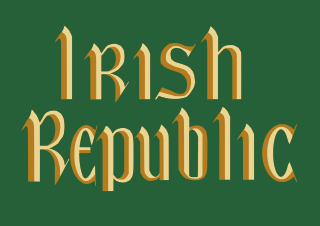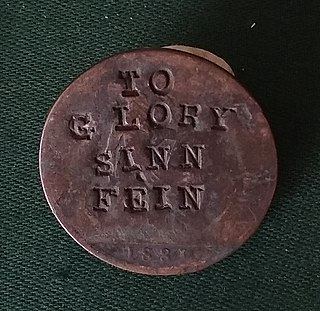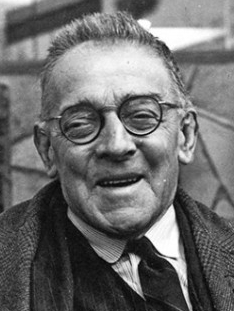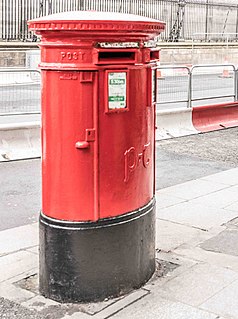
The Easter Rising, also known as the Easter Rebellion, was an armed insurrection in Ireland during Easter Week in April 1916. The Rising was launched by Irish republicans against British rule in Ireland with the aim of establishing an independent Irish Republic while the United Kingdom was fighting the First World War. It was the most significant uprising in Ireland since the rebellion of 1798 and the first armed conflict of the Irish revolutionary period. Sixteen of the Rising's leaders were executed from May 1916. The nature of the executions, and subsequent political developments, ultimately contributed to an increase in popular support for Irish independence.

Arthur Joseph Griffith was an Irish writer, newspaper editor and politician who founded the political party Sinn Féin. He led the Irish delegation at the negotiations that produced the 1921 Anglo-Irish Treaty, and served as the president of Dáil Éireann from January 1922 until his death later in August.

Seán Mac Diarmada, also known as Seán MacDermott, was an Irish republican political activist and revolutionary leader. He was one of the seven leaders of the Easter Rising of 1916, which he helped to organise as a member of the Military Committee of the Irish Republican Brotherhood (IRB) and was a signatory of the Proclamation of the Irish Republic. He was executed for his part in the Rising at age 33.

Republican Sinn Féin or RSF is an Irish republican political party in Ireland. RSF claims to be heirs of the Sinn Féin party founded in 1905 and took its present form in 1986 following a split in Sinn Féin. RSF members take seats when elected to local government in the Republic of Ireland, but do not recognise the validity of the Partition of Ireland. It subsequently does not recognise the legitimacy of the parliaments of Northern Ireland (Stormont) or the Republic of Ireland, so the party does not register itself with them.

Mulhuddart is an outer suburb situated 12 km north-west of Dublin, Ireland. The River Tolka passes near the village.
Events in the year 1966 in Ireland.
Events from the year 1891 in Ireland.

Cumann na mBan, abbreviated C na mB, is an Irish republican women's paramilitary organisation formed in Dublin on 2 April 1914, merging with and dissolving Inghinidhe na hÉireann, and in 1916, it became an auxiliary of the Irish Volunteers. Although it was otherwise an independent organisation, its executive was subordinate to that of the Irish Volunteers, and later, the Irish Republican Army.
James Colbert was an Irish politician and farmer.

Piaras Béaslaí was an Irish author, playwright, biographer and translator, who was a member of the Irish Republican Brotherhood, fought in the Easter Rising and served as a member of Dáil Éireann.

Sinn Féin and Sinn Féin Amháin are Irish-language phrases used as a political slogan by Irish nationalists in the late nineteenth and early twentieth century. While advocating Irish national self-reliance, its precise political meaning was undefined, variously interpreted as the aim of a separate Irish republic or that of a dual monarchy. Its earliest use was to describe individual political radicals unconnected with any party and espousing a more "advanced nationalism" than the Irish Home Rule movement represented by the Irish Parliamentary Party (IPP). In the 1890s "Sinn Féin, Sinn Féin amháin" was the slogan of the Gaelic League, which advocated the revival of the Irish language.

Kathleen Clarke was a founder member of Cumann na mBan, a women's paramilitary organisation formed in Ireland in 1914, and one of very few privy to the plans of the Easter Rising in 1916. She was the wife of Tom Clarke and sister of Ned Daly, both of whom were executed for their part in the Rising. She was subsequently a Teachta Dála (TD) and Senator with both Sinn Féin and Fianna Fáil, and the first female Lord Mayor of Dublin (1939–1941).

St. Finbarr's Cemetery in Cork, Ireland, is the city's largest and one of the oldest cemeteries in Ireland which is still in use. Located on the Glasheen Road, it was first opened in the 1860s. The entrance gateway was erected circa 1865, and the mortuary chapel consecrated in 1867.
Events from the year 1878 in Ireland.

Michael Patrick Colivet was an Irish Sinn Féin politician. He was Commander of the Irish Volunteers in Limerick during the 1916 Easter Rising, and was elected to the First Dáil.

Seán McGarry was a 20th-century Irish nationalist and politician. A longtime senior member of the Irish Republican Brotherhood (IRB), he served as its president from May 1917 until May 1918 when he was one of a number of nationalist leaders arrested for his alleged involvement in the so-called German Plot.
Henry Dixon was an Irish republican. He was a member of several nineteenth-century nationalist societies, a founding member of Sinn Féin, and a director of the Sinn Féin Printing & Publishing Company.

Joe Clarke was an Irish republican politician.

Fiona Plunkett 11 January 1896 – 12 July 1977 was an Irish republican involved in the organisation of the Easter 1916 Rising and a leading member of Cumann na mBan.

The centenary of the Easter Rising occurred in 2016. Many events occurred to mark the occasion. Note that Easter Day fell on 27 March in 2016 and on 23 April in 1916. The Rising began on Easter Monday, 24 April 1916.















